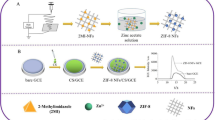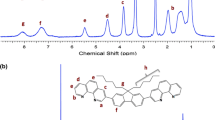Abstract
A novel solid-state electrochemiluminescence (ECL) sensor for chlorpyrifos (CPF) detection was constructed based on zeolitic imidazolate framework-67 electrospinning nanofibers (ZIF-67 NFs). Silver nanoparticles (Ag NPs), ZIF-67 NFs, tris(2,2′-bipyridyl) ruthenium(II) [Ru(bpy)32+], and Nafion were successively deposited on the surface of the electrode. Ag NPs played a role in promoting electron transfer, and ZIF-67 NFs played a role in fixing Ru(bpy)32+ and promoting electron transfer due to its large specific surface area and porosity. Nafion formed a film on the outermost layer of the electrode to further improve the stability of the system. Therefore, the modified electrode showed stable and obvious ECL signal in PBS solution containing 10 μL 0.01 M TprA (pH 8.0). CPF quenched the ECL signal of the system, and the quenching value was linear with the logarithm of CPF concentration in the range 1.0 × 10−13 to 1.0 × 10−6 M. The detection limit was 3.3 × 10−14 M (S/N = 3). In this study, ZIF-67 NFs were used as an ECL promoter for the first time, broadening the application range of ZIF-67 NFs.
Graphical abstract






Similar content being viewed by others
References
Quatrin GD, Pizzutti IR, Gebler L, Dias JV, Cardoso CD (2020) New analytical method for chlorpyrifos determination in biobeds constructed in Brazil: development and validation. J Chromatogr B 1157:122285. https://doi.org/10.1016/j.jchromb.2020.122285
Chen S, Jiang JL, Zhang HC, Liu RB, Zhou JY, Shan ZJ, Bu YQ (2020) Registration status of chlorpyrifos products for use on rice and its risk assessment for aquatic ecosystem in China. China Environ Sci 6:1–3. https://doi.org/10.19674/j.cnki.issn1000-6923.20200601.001
Nagabooshanam S, Roy S, Deshmukh S (2020) Wadhwa S, Sulania I, Mathur A, Krishnamurthy S, Bharadwaj LM, Roy SS Microfluidic affinity sensor based on a molecularly imprinted polymer for ultrasensitive detection of chlorpyrifos. ACS Omega 5:31765–31773. https://doi.org/10.1021/acsomega.0c04436
Shi QP, Guo W, Shen QC, Han J, Lei L, Chen LG, Yang LH, Feng CL, Zhou BS (2021) In vitro biolayer interferometry analysis of acetylcholinesterase as a potential target of aryl-organophosphorus flame-retardants. J Hazard Mater 409:124999. https://doi.org/10.1016/j.jhazmat.2020.124999
Xu GL, Huo DQ, Hou CJ, Zhao YN, Bao J, Yang M, Fa HB (2018) A regenerative and selective electrochemical aptasensor based on copper oxide nanoflowers-single walled carbon nanotubes nanocomposite for chlorpyrifos detection. Talanta 178:1046–1052. https://doi.org/10.1016/j.talanta.2017.08.086
Harshit D, Charmy K, Nrupesh P (2017) Organophosphorus pesticides determination by novel HPLC and spectrophotometric method. Food Chem 230:448–453. https://doi.org/10.1016/j.foodchem.2017.03.083
Schwantes D, Gonçalves AC Jr, Junior ÉC, Campagnolo MA, Zimmermann J (2020) Determination of chlorpyrifos by GC/ECD in water and its sorption mechanism study in a RHODIC FERRALSOL. J Environ Health Sci 18:149–162. https://doi.org/10.1007/s40201-020-00448-1
Cacho JI, Campillo N, Vinas P, Hernandez-Cordoba M (2018) In situ ionic liquid dispersive liquid-liquid microextraction coupled to gas chromatography-mass spectrometry for the determination of organophosphorus pesticides. J Chromatogr A 1559:95–101. https://doi.org/10.1016/j.chroma.2017.12.059
Ma P, Wang LY, Xu L, Li JY, Zhang XD, Chen H (2020) Rapid quantitative determination of chlorpyrifos pesticide residues in tomatoes by surface-enhanced Raman spectroscopy. Eur Food Res Technol 246:239–251. https://doi.org/10.1007/s00217-019-03408-8
Liu JH, Chen PP, Xia FQ, Liu Z, Liu HB, Yi JL, Zhou CL (2020) Sensitive electrochemiluminescence aptasensor for chlorpyrifos detection based on resonance energy transfer between MoS2/CdS nanospheres and Ag/CQDs. Sens Actuators B Chem 315:128098. https://doi.org/10.1016/j.snb.2020.128098
Miao SS, Wu MS, Ma LY, He XJ, Yang H (2016) Electrochemiluminescence biosensor for determination of organophosphorous pesticides based on bimetallic Pt-Au/multi-walled carbon nanotubes modified electrode. Talanta 158:142–151. https://doi.org/10.1016/j.talanta.2016.05.030
Kamyabi MA, Moharramnezhad M (2021) An enzyme-free electrochemiluminescence sensing probe based on ternary nanocomposite for ultrasensitive determination of chlorpyrifos. Food Chem 351:129252. https://doi.org/10.1016/j.foodchem.2021.129252
Kamyabi MA, Moharramnezhad M (2020) An ultra-sensitive electrochemiluminescence platform based on ZnONPs/Ni-foam and K2S2O8 for detection of chlorpyrifos. J Electroanal Chem 865:114120. https://doi.org/10.1016/j.jelechem.2020.114120
Babamiri B, Bahari D, Salimi A (2019) Highly sensitive bioaffinity electrochemiluminescence sensors: recent advances and future directions. Biosens Bioelectron 142:111530. https://doi.org/10.1016/j.bios.2019.111530
Ye YS, Wang LY, Liu KM, Li JG (2020) A label-free and sensitive electrochemiluminescence sensor based on a simple one-step electrodeposition of Go/ZnS modified electrode for trace copper ions detection. Microchem J 155:104749. https://doi.org/10.1016/j.microc.2020.104749
Zuo FM, Zhang H, Xie J, Chen SH, Yuan R (2018) A sensitive ratiometric electrochemiluminescence biosensor for hypoxanthine detection by in situ generation and consumption of coreactants. Electrochim Acta 271:173–179. https://doi.org/10.1016/j.electacta.2018.03.132
Xie SB, Dong YG, Yuan YL, Chai YQ, Yuan R (2016) Ultrasensitive lipopolysaccharides detection based on doxorubicin conjugated N-(aminobutyl)-N-(ethylisoluminol) as electrochemiluminescence indicator and self-assembled tetrahedron DNA dendrimers as nanocarriers. Anal Chem 88:5218–5224. https://doi.org/10.1021/acs.analchem.6b00276
Jiang D, Du XJ, Liu Q, Zhou L, Qian J, Wang K (2015) One-step thermal-treatment route to fabricate well-dispersed ZnO nanocrystals on nitrogen-doped graphene for enhanced electrochemiluminescence and ultrasensitive detection of pentachlorophenol. ACS Appl Mater Inter 7:3093–4100. https://doi.org/10.1021/am507163z
Chen F, Li HL, Yan JL, Guo HM, Tu YF (2017) Progress of the electrochemiluminescence biosensing strategy for clinical diagnosis with luminol as the sensing probe. ChemElectroChem 4:1587–1593. https://doi.org/10.1002/celc.201700465
LuJ WY, Shan XY, Sun Z, Zhang X, Zhao YJ, Hu Y, Sun EJ, Tian L (2021) Synergistic enhancement effects of cobalt oxide doped silver oxide and porphyrin zinc on an electrochemiluminescence sensor for detection of glucose. Microchem J 170:106716. https://doi.org/10.1016/j.microc.2021.106716
Gao XQ, Gu XW, Min Q, Wei YY, Tian CY, Zhuang XM, Luan F (2022) Encapsulating Ru(bpy)32+ in an infinite coordination polymer network: towards a solid-state electrochemiluminescence sensing platform for histamine to evaluate fish product quality. Food Chem 368:130852. https://doi.org/10.1016/j.foodchem.2021.130852
Lian XZ, Fang Y, Joseph E, Wang Q, Li JL, Banerjee S, Lollar C, Wang X, Zhou HC (2017) Enzyme–MOF (metal–organic framework) composites. Chem Soc Rev 46:3386–3401. https://doi.org/10.1039/C7CS00058H
Huang YB, Liang J, Wang XS, Cao R (2017) Multifunctional metal–organic framework catalysts: synergistic catalysis and tandem reactions. Chem Soc Rev 46:126–157. https://doi.org/10.1039/C6CS00250A
Wu MX, Yang YW (2017) Metal–organic framework (MOF)-based drug/cargo delivery and cancer therapy. Adv Mater 29:1606134. https://doi.org/10.1002/adma.201606134
Gong W, Yang SQ, Zhang F, Tian FS, Chen JM, Yin ZG, Ding SJ, Yang W, Luo R (2021) A dual-quenched ECL immunosensor for ultrasensitive detection of retinol binding protein 4 based on luminol@AuPt/ZIF-67 and MnO2@CNTs. J Nanobiotechnol 19:272. https://doi.org/10.1186/s12951-021-01020-1
Chen TY, Kuo TR, Yougbaré S, Lin LY, Xiao CY (2022) Novel direct growth of ZIF-67 derived Co3O4 and N-doped carbon composites on carbon cloth as supercapacitor electrodes. J Colloid Interf Sci 608:493–503. https://doi.org/10.1016/j.jcis.2021.09.198
Zhao GH, Wang YG, Li XJ, Yue Q, Dong X, Du B, Cao W, Wei Q (2019) Dual-quenching electrochemiluminescence strategy based on three-dimensional metal−organic frameworks for ultrasensitive detection of amyloid-β. Anal Chem 91:1989–1996. https://doi.org/10.1021/acs.analchem.8b04332
Wang XY, Xiao SY, Yang CP, Hu CY, Wang X, Zhen SJ, Huang CZ, Li YF (2021) Zinc−metal organic frameworks: a coreactant-free electrochemiluminescence luminophore for ratiometric detection of miRNA-133a. Anal Chem 93:14178–14186. https://doi.org/10.1021/acs.analchem.1c02881
Yao LY, Yang F, Liang WB, Hu GB, Yang Y, Huang W, Yuan R, Xiao DR (2019) Ruthenium complex doped metal-organic nanoplate with high electrochemiluminescent intensity and stability for ultrasensitive assay of mucin 1. Sens Actuators B Chem 292:105–110. https://doi.org/10.1016/j.snb.2019.04.130
Mo GC, He XM, Qin DM, Meng S, Wu YS, Deng BY (2021) Spatially-resolved dual-potential sandwich electrochemiluminescence immunosensor for the simultaneous determination of carbohydrate antigen 19–9 and carbohydrate antigen 24–2. Biosens Bioelectron 178:113024. https://doi.org/10.1016/j.bios.2021.113024
Xu Y, Yin XB, He XW, Zhang YK (2015) Electrochemistry and electrochemiluminescence from a redox-active metal-organic framework. Biosens Bioelectron 68:197–203. https://doi.org/10.1016/j.bios.2014.12.031
Wang SS, Zhao YY, Wang MM, Li HJ, Saqib M, Ge CH, Zhang XD, Jin YD (2019) Enhancing luminol electrochemiluminescence by combined use of cobalt-based metal organic frameworks and silver nanoparticles and Its application in ultrasensitive detection of cardiac Troponin I. Anal Chem 91:3048–3054. https://doi.org/10.1021/acs.analchem.8b05443
Li LB, Zhou LM, Liu XH, You TY (2020) Ultrasensitive self-enhanced electrochemiluminescence sensor based on novel PAN@Ru@PEI@Nafion nanofiber mat. J Mater Chem B 8:3590–3597. https://doi.org/10.1039/C9TB02287B
Wang XY, Yang Y, Gao HW (2014) A novel solid-state electrochemiluminescence quenching sensor for detection of aniline based on luminescent composite nanofibers. J Lumin 156:229–234. https://doi.org/10.1016/j.jlumin.2014.08.021
Wang XY, Wang YJ, Shan YQ, Jiang M, Li JL (2016) Sensitive determination of bisphenol A using a novel solid-state electrochemiluminescence quenching sensor. Int J Environ An Ch 96:1480–1490. https://doi.org/10.1080/03067319.2016.1271879
Wang XY, Wang YJ, Jiang M, Shan YQ, Wang XB (2017) On-site determination of bisphenol A in river water by a novel solid-state electrochemiluminescence quenching sensor. Environ Chem 14:115–122. https://doi.org/10.1071/EN16137
Wang XY, Wang YJ, Jiang M, Shan YQ, Jin X, Gong M, Wang BX (2018) Functional electrospun nanofibers-based electrochemiluminescence immunosensor for detection of the TSP 53 using RuAg/SiO2 NPs as signal enhancers. Anal Biochem 548:15–22. https://doi.org/10.1016/j.ab.2018.02.006
Wang XY, Wang YJ, Shan YQ, Jiang M, Gong M, Jin X, Wang XB, Cheng J (2018) An electrochemiluminescence biosensor for detection of CdkN2A/p16 anti-oncogene based on functional electrospun nanofibers and core-shell luminescent composite nanoparticles. Talanta 187:179–187. https://doi.org/10.1016/j.talanta.2018.05.033
Zhang CL, Lu BR, Cao FH, Wu ZY, Zhang W, Cong HP, Yu SH (2019) Electrospun metal-organic framework nanoparticle fibers and their derived electrocatalysts for oxygen reduction reaction. Nano Energy 55:226–233. https://doi.org/10.1016/j.nanoen.2018.10.029
Mirzaei R, Bahadori M, Kardanpour R, Rafiei S, Tangestaninejad S, Moghadam M, Mirkhani V, Mohammadpoor-Baltork I, Mirazimi SE (2021) Preparation and characterization of nanofibrous metal–organic frameworks as efficient catalysts for the synthesis of cyclic carbonates in solvent-free conditions. Dalton Trans 50:10567. https://doi.org/10.1039/D1DT01336J
Jin L, Ye J, Wang Y, Qian XY, Dong MD (2019) Electrospinning synthesis of ZIF-67/PAN fibrous membrane with high-capacity adsorption for malachite green. Fiber Polym 20:2070–2077. https://doi.org/10.1007/s12221-019-1196-7
Guo X, Xing T, Lou Y, Chen J (2016) Controlling ZIF-67 crystals formation through various cobalt sources in aqueous solution. J Solid State Chem 235:107–112. https://doi.org/10.1016/j.jssc.2015.12.021
Meng HJ, Liu YM, Liu HR, Pei SP, Yuan XX, Li H, Zhang YM (2020) ZIF67@MFC-derived Co/N-C@CNFs interconnected frameworks with graphitic carbon-encapsulated Co nanoparticles as highly stable and efficient electrocatalysts for oxygen reduction reactions. ACS Appl Mater Interfaces 12:41580–41589. https://doi.org/10.1021/acsami.0c12069
Shan D, Qian B, Ding SN, Zhu W, Cosnier S, Xue HG (2010) Enhanced solid-state electrochemiluminescence of tris(2,2’-bipyridyl)ruthenium(II) incorporated into electrospun nanofibrous. Mat Anal Chem 82:5892–5896. https://doi.org/10.1021/ac100435z
Zhou CS, Luo JJ, Zhang L, Long YY, Wang CM, Xiao D (2014) An electrochemiluminescence amplification strategy: a synergistic effect of electrospun Ru(bpy)32+/CNT/ionic liquid composite nanofibers. J Mater Chem C 2:9949–9956. https://doi.org/10.1039/C4TC01755B
Babaahmadi V, Montazer M, Gao W (2017) Low temperature welding of graphene on PET with silver nanoparticles producing higher durable electro-conductive fabric. Carbon 118:443–451. https://doi.org/10.1016/j.carbon.2017.03.066
Pashaei B, Shahroosvand H, Moharramnezhad M, Kamyabi MA, Bakhshi H, Pilkington M, Nazeeruddin MK (2021) Two in one: a dinuclear Ru(II) complex for deep-red light-emitting electrochemical cells and as an electrochemiluminescence probe for organophosphorus pesticides. Inorg Chem 60:17040–17050. https://doi.org/10.1021/acs.inorgchem.1c02154
Zahran M, Khalifa Z, Zahran MA-H, Azzem MA (2021) Abiotic sensor for electrochemical determination of chlorpyrifos in natural water based on the inhibition of silver nanoparticles oxidation. Microchem J 165:106173. https://doi.org/10.1016/j.microc.2021.106173
Sun Z, Wang W, Wen H, Gan C, Lei H, Liu Y (2015) Sensitive electrochemical immunoassay for chlorpyrifos by using flake-like Fe3O2 modified carbon nanotubes as the enhanced multienzyme label. Anal Chim Acta 899:91–99. https://doi.org/10.1016/j.aca.2015.09.057
Funding
We received financial support from Jilin Natural Science Foundation (YDZJ202201ZYTS663).
Author information
Authors and Affiliations
Corresponding authors
Ethics declarations
Competing interests
The authors declare no competing interests.
Additional information
Publisher's note
Springer Nature remains neutral with regard to jurisdictional claims in published maps and institutional affiliations.
Supplementary Information
Below is the link to the electronic supplementary material.
Rights and permissions
Springer Nature or its licensor holds exclusive rights to this article under a publishing agreement with the author(s) or other rightsholder(s); author self-archiving of the accepted manuscript version of this article is solely governed by the terms of such publishing agreement and applicable law.
About this article
Cite this article
Lu, J., Shan, X., Wu, Q. et al. Solid-state electrochemiluminescence sensor based on zeolitic imidazolate framework-67 electrospinning nanofibers for chlorpyrifos detection. Microchim Acta 189, 298 (2022). https://doi.org/10.1007/s00604-022-05398-z
Received:
Accepted:
Published:
DOI: https://doi.org/10.1007/s00604-022-05398-z




